Deletion of the huntingtin polyglutamine stretch enhances neuronal autophagy and longevity in mice
- PMID: 20140187
- PMCID: PMC2816686
- DOI: 10.1371/journal.pgen.1000838
Deletion of the huntingtin polyglutamine stretch enhances neuronal autophagy and longevity in mice
Abstract
Expansion of a stretch of polyglutamine in huntingtin (htt), the protein product of the IT15 gene, causes Huntington's disease (HD). Previous investigations into the role of the polyglutamine stretch (polyQ) in htt function have suggested that its length may modulate a normal htt function involved in regulating energy homeostasis. Here we show that expression of full-length htt lacking its polyglutamine stretch (DeltaQ-htt) in a knockin mouse model for HD (Hdh(140Q/DeltaQ)), reduces significantly neuropil mutant htt aggregates, ameliorates motor/behavioral deficits, and extends lifespan in comparison to the HD model mice (Hdh(140Q/+)). The rescue of HD model phenotypes is accompanied by the normalization of lipofuscin levels in the brain and an increase in the steady-state levels of the mammalian autophagy marker microtubule-associate protein 1 light chain 3-II (LC3-II). We also find that DeltaQ-htt expression in vitro increases autophagosome synthesis and stimulates the Atg5-dependent clearance of truncated N-terminal htt aggregates. DeltaQ-htt's effect on autophagy most likely represents a gain-of-function, as overexpression of full-length wild-type htt in vitro does not increase autophagosome synthesis. Moreover, Hdh(DeltaQ/DeltaQ) mice live significantly longer than wild-type mice, suggesting that autophagy upregulation may be beneficial both in diseases caused by toxic intracellular aggregate-prone proteins and also as a lifespan extender in normal mammals.
Conflict of interest statement
The authors have declared that no competing interests exist.
Figures
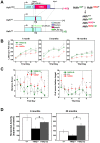

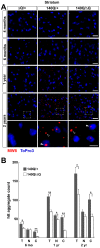
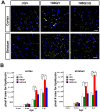
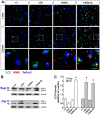
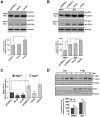
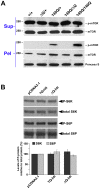

Similar articles
-
A series of N-terminal epitope tagged Hdh knock-in alleles expressing normal and mutant huntingtin: their application to understanding the effect of increasing the length of normal Huntingtin's polyglutamine stretch on CAG140 mouse model pathogenesis.Mol Brain. 2012 Aug 14;5:28. doi: 10.1186/1756-6606-5-28. Mol Brain. 2012. PMID: 22892315 Free PMC article.
-
Deletion of the triplet repeat encoding polyglutamine within the mouse Huntington's disease gene results in subtle behavioral/motor phenotypes in vivo and elevated levels of ATP with cellular senescence in vitro.Hum Mol Genet. 2006 Feb 15;15(4):607-23. doi: 10.1093/hmg/ddi477. Epub 2006 Jan 10. Hum Mol Genet. 2006. PMID: 16403806
-
The regulation of autophagosome dynamics by huntingtin and HAP1 is disrupted by expression of mutant huntingtin, leading to defective cargo degradation.J Neurosci. 2014 Jan 22;34(4):1293-305. doi: 10.1523/JNEUROSCI.1870-13.2014. J Neurosci. 2014. PMID: 24453320 Free PMC article.
-
Huntington's Disease.Cold Spring Harb Perspect Biol. 2011 Jun 1;3(6):a007476. doi: 10.1101/cshperspect.a007476. Cold Spring Harb Perspect Biol. 2011. PMID: 21441583 Free PMC article. Review.
-
[Huntington's disease: intracellular signaling pathways and neuronal death].J Soc Biol. 2005;199(3):247-51. doi: 10.1051/jbio:2005026. J Soc Biol. 2005. PMID: 16471265 Review. French.
Cited by
-
Small Molecule Pytren-4QMn Metal Complex Slows down Huntington's Disease Progression in Male zQ175 Transgenic Mice.Int J Mol Sci. 2023 Oct 13;24(20):15153. doi: 10.3390/ijms242015153. Int J Mol Sci. 2023. PMID: 37894844 Free PMC article.
-
Impact of differential and time-dependent autophagy activation on therapeutic efficacy in a model of Huntington disease.Autophagy. 2021 Jun;17(6):1316-1329. doi: 10.1080/15548627.2020.1760014. Epub 2020 May 6. Autophagy. 2021. PMID: 32374203 Free PMC article.
-
HdhQ111 Mice Exhibit Tissue Specific Metabolite Profiles that Include Striatal Lipid Accumulation.PLoS One. 2015 Aug 21;10(8):e0134465. doi: 10.1371/journal.pone.0134465. eCollection 2015. PLoS One. 2015. PMID: 26295712 Free PMC article.
-
Mitochondrial Ca(2+) and neurodegeneration.Cell Calcium. 2012 Jul;52(1):73-85. doi: 10.1016/j.ceca.2012.04.015. Epub 2012 May 18. Cell Calcium. 2012. PMID: 22608276 Free PMC article. Review.
-
Primary cilia and autophagic dysfunction in Huntington's disease.Cell Death Differ. 2015 Sep;22(9):1413-24. doi: 10.1038/cdd.2015.80. Epub 2015 Jul 10. Cell Death Differ. 2015. PMID: 26160070 Free PMC article. Review.
References
-
- Atwal RS, Xia J, Pinchev D, Taylor J, Epand RM, et al. Huntingtin has a membrane association signal that can modulate huntingtin aggregation, nuclear entry and toxicity. Hum Mol Genet. 2007;16:2600–2615. - PubMed
-
- Faber PW, Barnes GT, Srinidhi J, Chen J, Gusella JF, et al. Huntingtin interacts with a family of WW domain proteins. Hum Mol Genet. 1998;7:1463–1474. - PubMed
-
- Gao YG, Yan XZ, Song AX, Chang YG, Gao XC, et al. Structural Insights into the specific binding of huntingtin proline-rich region with the SH3 and WW domains. Structure. 2006;14:1755–1765. - PubMed
-
- Liu YF, Deth RC, Devys D. SH3 domain-dependent association of huntingtin with epidermal growth factor receptor signaling complexes. J Biol Chem. 1997;272:8121–8124. - PubMed
-
- The Huntington's Disease Collaborative Research Group. A novel gene containing a trinucleotide repeat that is expanded and unstable on Huntington's disease chromosomes. Cell. 1993;72:971–983. - PubMed
Publication types
MeSH terms
Substances
Grants and funding
LinkOut - more resources
Full Text Sources
Molecular Biology Databases
Research Materials
Miscellaneous

